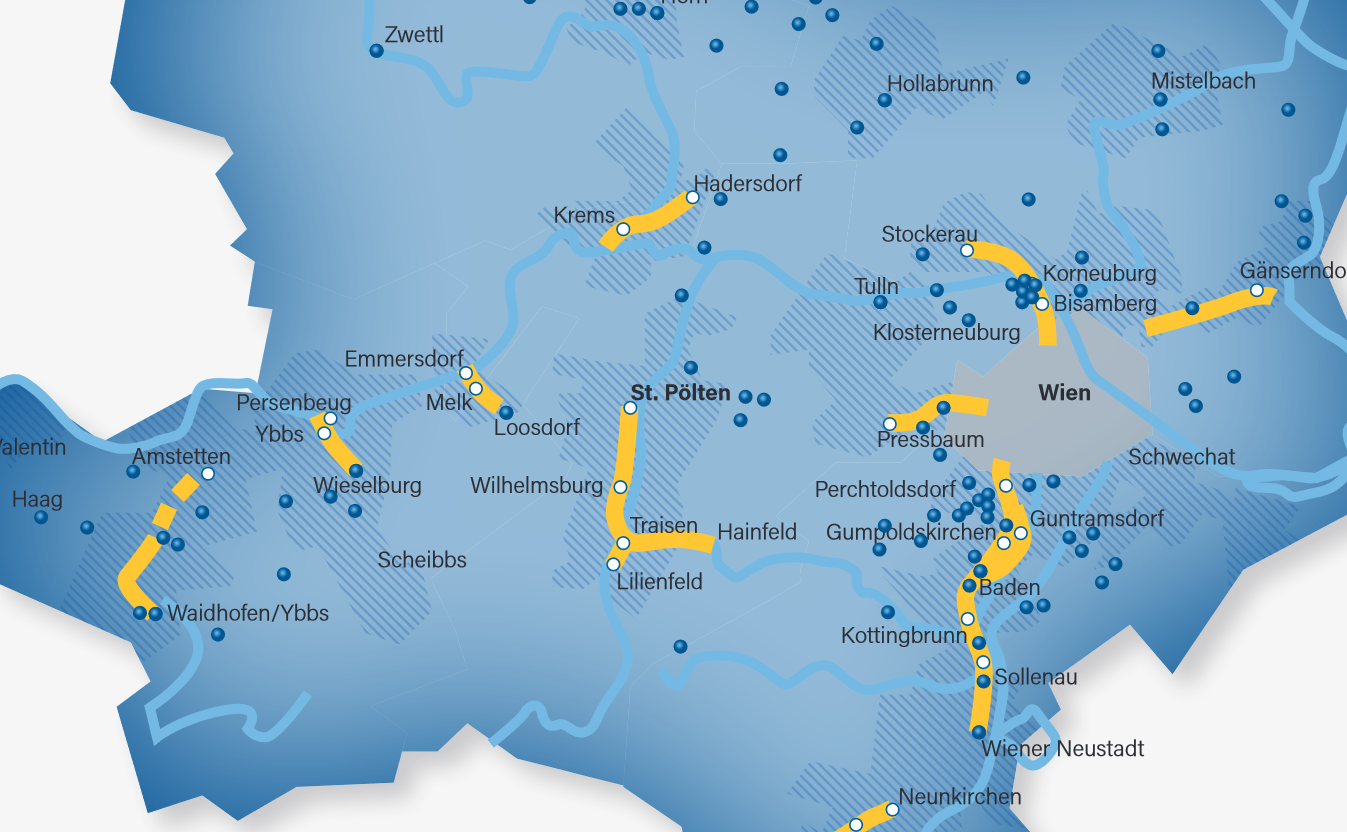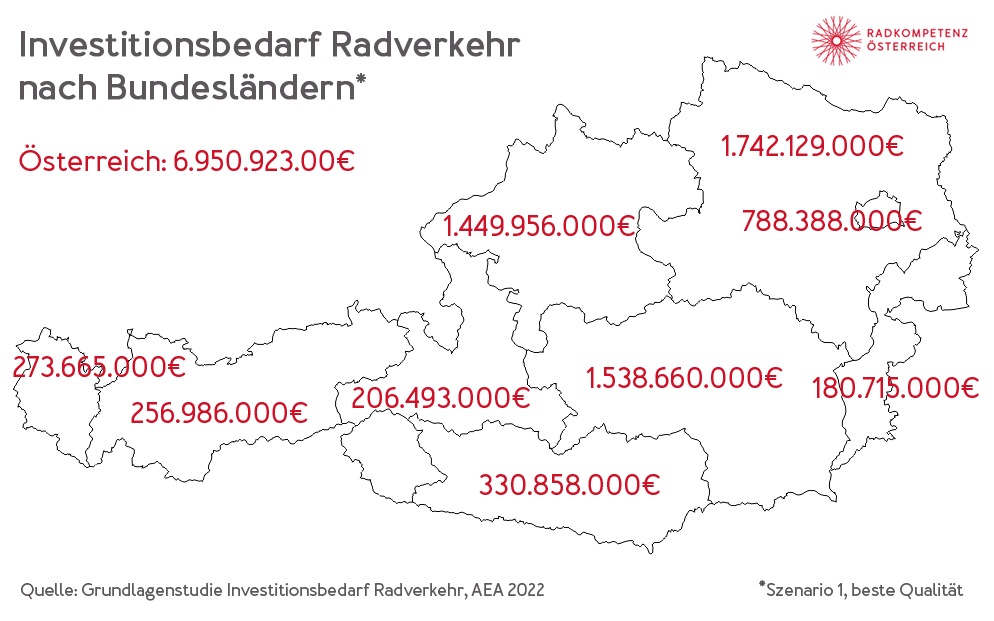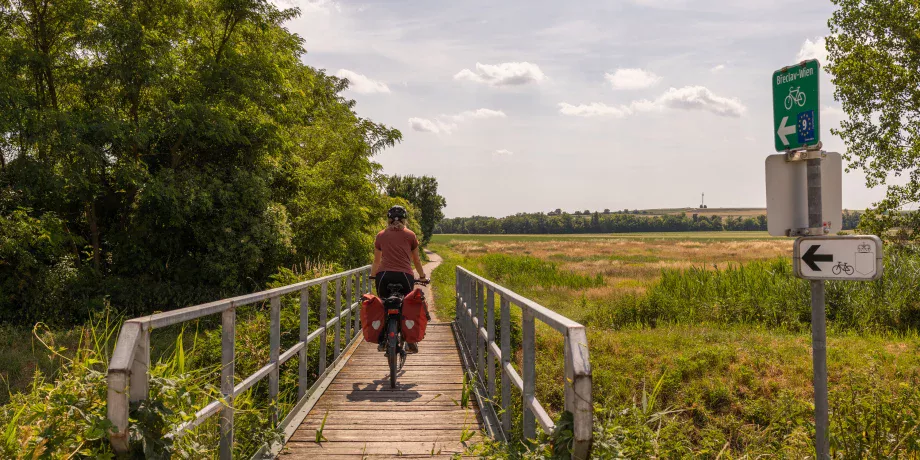Focus on Lower Austria: Investment needs and measurements

Lower Austria, thanks to increased measures and financial support for municipalities in the cycling sector, is one of the most active federal states in Austria in this area. However, the state faces the challenge of having to make up for the failures of recent decades and has to overcome significant hurdles due to its large area and long car commuting routes. After the government reshuffle in the 2023 state elections, the question arises: Will Lower Austria continue to pursue the path towards better cycling infrastructure? According to the investment study on cycling, Lower Austria lacks 850 km of structurally separated cycle paths.
1.7 billion euros required for cycling infrastructure in Lower Austria
In April 2022, a study by the Cycle Competence members Planoptimo and Verracon, commissioned by the Ministry for Climate Protection and all nine federal states, analysed what measures and investment sums are needed to get more people cycling in Austria. For the whole of Austria, this would require up to 7 billion euros in the best case. In this scenario, the identified expansion needs for structurally separated infrastructure would be fully implemented. Lower Austria accounts for a large part of this, due to its size and population: 1.7 billion euros are needed to make Lower Austria cycling-fit in all areas, from infrastructure construction to staffing, education, and communication.
This amount represents an expenditure of 1,000 euros per capita in Lower Austria, or no more than 100 euros per capita per year over a period of at least ten years. However, the study does not provide a specific timeframe for the construction measures, and the amount could be invested over a longer period. Nevertheless, effective measures against the climate crisis are urgently needed in the transport sector.
This graphic shows the investment needed per state for the whole of Austria.
850 kilometers of additional cycle paths
As of 2022, Lower Austria has 800 km of cycling infrastructure, according to the study. If the existing 250 km of 30 km/h zones and 120 km of traffic-calmed areas are added, this results in a patchy cycling network of 1,180 km, the condition of which does not consistently meet the standard of the current guidelines. With a target network of around 5,350 km for cycling, an expansion requirement of 4,170 km exists, which should be covered by 20% structurally separated cycling infrastructure. This would amount to 850 km of cycle paths in Lower Austria according to this calculation.
EuroVelo 9 in Lower Austria is a well-developed route for cycle tourism.
The investment for cycle path construction was estimated in the study on a per-kilometer basis. A rate of 80,000 euros was used nationwide for one kilometer of cycle infrastructure or similar reconfigurations of the road space, while one kilometer of mixed traffic infrastructure cost 10,000 euros. One kilometer of structurally separated cycling infrastructure costs 580,000 euros in Lower Austria. The investment need for regional cycling networks in Austria alone is around 3.67 billion euros according to this approach.
A large part of these investments is allocated to the three federal states with large surface areas – Upper Austria at 951 million euros, Lower Austria at 917 million euros, and Styria at 843 million euros. All amounts are based on the body of knowledge as of 2022. The costs would have to be shared jointly by all levels of government (federal, state, and municipal).
Status of projects in Lower Austria
The state of Lower Austria is currently supporting municipalities intensively with the planning of bicycle networks and expansion projects, as well as financially with funding rates of 60-80% for the construction of bicycle infrastructure. In the long term, Lower Austria plans to create a high-quality cycle superhighway connection from Vienna to Wiener Neustadt as part of the “blue-yellow cycling offensive“, as well as other cycle superhighway corridors throughout the country. Specific routes from Stockerau via Korneuburg and Bisamberg towards Vienna, and from Gänserndorf, Straßhof and Deutsch Wagram towards Vienna were named in January 2023 by the then Provincial Councillor Ludwig Schleritzko (ÖVP). With the inauguration of the new state government in March 2023, Udo Landbauer (FPÖ) became the new Deputy Governor of Infrastructure and Transport, and nothing is currently known about continuing funding measures in the coming years.
“Our goal is clear: we want to further focus on active mobility. We want Lower Austria to become even more of a ‘bicycle county’. In numerical terms, we want to increase the proportion of active mobility from the current 22% to 40%,” said Landbauer’s predecessor, Schleritzko. For 2023, he announced a budget of more than 20 million euros for bicycle infrastructure in Lower Austria.
Radland Niederösterreich provides a good overview of promoted cycling projects.
Financing with federal support
In 2021 and 2022, the state of Lower Austria invested a total of around 35 million euros together with the support of the Ministry for Climate Protection and municipalities, according to former regional councillor Schleritzko. In addition to construction and planning measures, awareness-raising measures are made possible by the state-owned agency for active mobility, Radland Niederösterreich. This agency funded and promoted courses, workshops, and events with over a quarter of a million euros last year. This includes participation in the nationwide “Austria cycles” campaign.
The state of Lower Austria’s funding rate for the construction of cycle superhighways represents up to 80% of the real-terms eligible investment costs, while it is up to 70% for measures included in the basic cycle network (“Förderschiene A”). The funding rate for the planning and construction of cycle traffic facilities in the course of cycle path connections is up to 70% of the real-terms eligible investment costs. The preparation of action plans for the expansion of cycle infrastructure is also supported with a funding rate of up to 70% of eligible costs, up to a maximum of €20,000 (“Förderschiene B”).
A large part of this funding is provided by the federal government through the funding programs of the Ministry for Climate Protection and its initiative klimaaktiv mobil. The funding rate of the ministry depends on the mix of measures and the project quality and can be up to 30% of the eligible costs. Cycle superhighways are even funded with 50% of the construction costs. These federal funding amounts are included in the funding from the state of Lower Austria.
References:
- Unser Artikel zur Investitionsstudie Radverkehr
- Die komplette Studie “Grundlagen Investitionsbedarf Radverkehr”
- Presseaussendung LR Schleritzko vom Jänner 2023
- Förderungen von klimaaktiv mobil
- Radland Niederösterreich zu Förderungen in NÖ
- Förderungsinformationen Land NÖ
Fotos: Niederösterreich Werbung/Franziska Consolati, con.sens
Cycling Competence Members in this article:
More articles with this member:
Share this article:
Focus on Lower Austria: Investment needs and measurements
Share this article:

Lower Austria, thanks to increased measures and financial support for municipalities in the cycling sector, is one of the most active federal states in Austria in this area. However, the state faces the challenge of having to make up for the failures of recent decades and has to overcome significant hurdles due to its large area and long car commuting routes. After the government reshuffle in the 2023 state elections, the question arises: Will Lower Austria continue to pursue the path towards better cycling infrastructure? According to the investment study on cycling, Lower Austria lacks 850 km of structurally separated cycle paths.
1.7 billion euros required for cycling infrastructure in Lower Austria
In April 2022, a study by the Cycle Competence members Planoptimo and Verracon, commissioned by the Ministry for Climate Protection and all nine federal states, analysed what measures and investment sums are needed to get more people cycling in Austria. For the whole of Austria, this would require up to 7 billion euros in the best case. In this scenario, the identified expansion needs for structurally separated infrastructure would be fully implemented. Lower Austria accounts for a large part of this, due to its size and population: 1.7 billion euros are needed to make Lower Austria cycling-fit in all areas, from infrastructure construction to staffing, education, and communication.
This amount represents an expenditure of 1,000 euros per capita in Lower Austria, or no more than 100 euros per capita per year over a period of at least ten years. However, the study does not provide a specific timeframe for the construction measures, and the amount could be invested over a longer period. Nevertheless, effective measures against the climate crisis are urgently needed in the transport sector.
This graphic shows the investment needed per state for the whole of Austria.
850 kilometers of additional cycle paths
As of 2022, Lower Austria has 800 km of cycling infrastructure, according to the study. If the existing 250 km of 30 km/h zones and 120 km of traffic-calmed areas are added, this results in a patchy cycling network of 1,180 km, the condition of which does not consistently meet the standard of the current guidelines. With a target network of around 5,350 km for cycling, an expansion requirement of 4,170 km exists, which should be covered by 20% structurally separated cycling infrastructure. This would amount to 850 km of cycle paths in Lower Austria according to this calculation.
EuroVelo 9 in Lower Austria is a well-developed route for cycle tourism.
The investment for cycle path construction was estimated in the study on a per-kilometer basis. A rate of 80,000 euros was used nationwide for one kilometer of cycle infrastructure or similar reconfigurations of the road space, while one kilometer of mixed traffic infrastructure cost 10,000 euros. One kilometer of structurally separated cycling infrastructure costs 580,000 euros in Lower Austria. The investment need for regional cycling networks in Austria alone is around 3.67 billion euros according to this approach.
A large part of these investments is allocated to the three federal states with large surface areas – Upper Austria at 951 million euros, Lower Austria at 917 million euros, and Styria at 843 million euros. All amounts are based on the body of knowledge as of 2022. The costs would have to be shared jointly by all levels of government (federal, state, and municipal).
Status of projects in Lower Austria
The state of Lower Austria is currently supporting municipalities intensively with the planning of bicycle networks and expansion projects, as well as financially with funding rates of 60-80% for the construction of bicycle infrastructure. In the long term, Lower Austria plans to create a high-quality cycle superhighway connection from Vienna to Wiener Neustadt as part of the “blue-yellow cycling offensive“, as well as other cycle superhighway corridors throughout the country. Specific routes from Stockerau via Korneuburg and Bisamberg towards Vienna, and from Gänserndorf, Straßhof and Deutsch Wagram towards Vienna were named in January 2023 by the then Provincial Councillor Ludwig Schleritzko (ÖVP). With the inauguration of the new state government in March 2023, Udo Landbauer (FPÖ) became the new Deputy Governor of Infrastructure and Transport, and nothing is currently known about continuing funding measures in the coming years.
“Our goal is clear: we want to further focus on active mobility. We want Lower Austria to become even more of a ‘bicycle county’. In numerical terms, we want to increase the proportion of active mobility from the current 22% to 40%,” said Landbauer’s predecessor, Schleritzko. For 2023, he announced a budget of more than 20 million euros for bicycle infrastructure in Lower Austria.
Radland Niederösterreich provides a good overview of promoted cycling projects.
Financing with federal support
In 2021 and 2022, the state of Lower Austria invested a total of around 35 million euros together with the support of the Ministry for Climate Protection and municipalities, according to former regional councillor Schleritzko. In addition to construction and planning measures, awareness-raising measures are made possible by the state-owned agency for active mobility, Radland Niederösterreich. This agency funded and promoted courses, workshops, and events with over a quarter of a million euros last year. This includes participation in the nationwide “Austria cycles” campaign.
The state of Lower Austria’s funding rate for the construction of cycle superhighways represents up to 80% of the real-terms eligible investment costs, while it is up to 70% for measures included in the basic cycle network (“Förderschiene A”). The funding rate for the planning and construction of cycle traffic facilities in the course of cycle path connections is up to 70% of the real-terms eligible investment costs. The preparation of action plans for the expansion of cycle infrastructure is also supported with a funding rate of up to 70% of eligible costs, up to a maximum of €20,000 (“Förderschiene B”).
A large part of this funding is provided by the federal government through the funding programs of the Ministry for Climate Protection and its initiative klimaaktiv mobil. The funding rate of the ministry depends on the mix of measures and the project quality and can be up to 30% of the eligible costs. Cycle superhighways are even funded with 50% of the construction costs. These federal funding amounts are included in the funding from the state of Lower Austria.
References:
- Unser Artikel zur Investitionsstudie Radverkehr
- Die komplette Studie “Grundlagen Investitionsbedarf Radverkehr”
- Presseaussendung LR Schleritzko vom Jänner 2023
- Förderungen von klimaaktiv mobil
- Radland Niederösterreich zu Förderungen in NÖ
- Förderungsinformationen Land NÖ
Fotos: Niederösterreich Werbung/Franziska Consolati, con.sens




